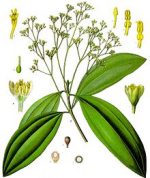 Also known as Chinese cinnamon, this evergreen tree is native to southern China and used there for 5000 years. It is a member of the laurel family, Lauracaea, that also included avocado. The tree grows up to 50′ tall and has grayish, aromatic bark, and leathery, oval leaves that are 4-6″ long and reddish when young. Panicles of small greenish-white flowers appear in spring and give way to clusters of purple-black drupes. The trees are cultivated for their bark, buds, twigs and friuts which are used to make cinnamon used in cooking and herbal medcine. The bark of Chinese cinnamon is thicker and harder to crush than that of of Ceylon cinnamon and its flavor less delicate. Most of the cinnamon sold in the US is probably Chinese cinnamon. Growing Chinese cinnamon in the US is limited to areas with a warm moist climate but the plants can be grown in containers and purned to maintain size. The genus name, Cinnamomum, is derived from the Maylasian/Indonesian word kayu manis meaning sweet wood. The specific epithet, cassia, is the Latin word meaning stip off bark.
Also known as Chinese cinnamon, this evergreen tree is native to southern China and used there for 5000 years. It is a member of the laurel family, Lauracaea, that also included avocado. The tree grows up to 50′ tall and has grayish, aromatic bark, and leathery, oval leaves that are 4-6″ long and reddish when young. Panicles of small greenish-white flowers appear in spring and give way to clusters of purple-black drupes. The trees are cultivated for their bark, buds, twigs and friuts which are used to make cinnamon used in cooking and herbal medcine. The bark of Chinese cinnamon is thicker and harder to crush than that of of Ceylon cinnamon and its flavor less delicate. Most of the cinnamon sold in the US is probably Chinese cinnamon. Growing Chinese cinnamon in the US is limited to areas with a warm moist climate but the plants can be grown in containers and purned to maintain size. The genus name, Cinnamomum, is derived from the Maylasian/Indonesian word kayu manis meaning sweet wood. The specific epithet, cassia, is the Latin word meaning stip off bark.
Type: Evergreen tree
Outstanding Feature: Bark
Form: Rounded
Growth Rate: Slow
Bloom: Panicles of small greenish white flowers from spring to summer
Size: Up to 50′
Light:Full sun to partial shade
Soil: Fertile, moist, well-drained, acid but tolerates neutral pH.
Hardiness: Zones 9-11
Care: Prune to maintain size.
Pests and Diseases: Numerous insects and diseases but most are not common outside of the tropics and semi tropics.
Propagation: Seed (low viability), cuttings of semi-soft side shoots
Photo Credit: Wikipedia